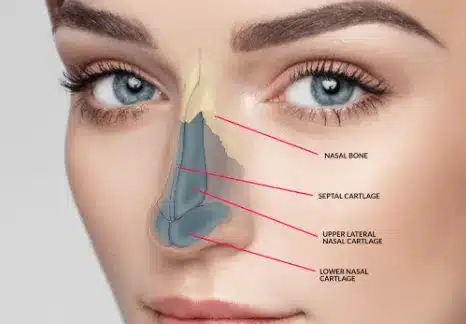The Roman nose, characterized by its famous bridge and downward-curved tip, is a distinctive facial feature that may cause individuals to consider a nose job for enhancement. In this article, we will explore the intricacies of nose jobs tailored explicitly to the Roman nose.
Types of Noses
Understanding the different types of noses, including the Roman nose, can provide valuable insights. Here are some common nose types:
- Roman Nose: features a prominent, arched bridge with a downward-curved tip, giving it an elegant and noble appearance.
- Fleshy Nose: A fleshy nose typically has more volume due to excess soft tissue. It may lack definition, appear larger, or have a rounded tip.
- Greek Nose: A Greek nose has a straight, narrow bridge with a well-defined tip.
- Snub Nose: This nose has a short and slightly upturned tip, often accompanied by a wider nasal base.
- Hawk Nose: Resembling a bird’s beak, a hawk nose has a prominent and curved bridge, with a downward-pointing tip.
Understanding the specific characteristics of your Roman nose will help guide your nose job journey.
Tips for Nose Jobs for the Roman Nose
For individuals considering a nose job for their Roman nose, here are five tips to consider:
- Consultation with an Experienced Surgeon: Seek a skilled and experienced plastic surgeon specializing in rhinoplasty. A consultation will allow you to discuss your concerns, goals, and expectations while enabling the surgeon to evaluate your Roman nose structure and provide expert advice.
- Clear Communication and Realistic Expectations: Openly communicate your desires and expectations with your surgeon. Having realistic expectations about the potential outcomes of a nose job for a Roman nose is crucial, as the goal is to enhance your unique features rather than completely alter them.
- Customized Approach for the Roman Nose: A skilled surgeon will customize the nose job procedure to suit the specific needs of your Roman nose. Techniques such as reducing the prominence of the bridge, refining the tip, or improving overall facial harmony may be employed.
- Preserving Ethnic and Natural Features: If you have a Roman nose of a particular ethnic background, preserving the natural characteristics that contribute to your unique identity is essential. Discuss your cultural considerations with your surgeon to ensure an aesthetically pleasing and culturally sensitive result.
- Post-operative Care and Patience: Follow your surgeon’s post-operative care instructions diligently. It is crucial to be patient during the healing process, as the final results of a nose job for a Roman nose may take several months to manifest due to swelling and tissue settling fully.
Benefits of a Nose Job for the Roman Nose
Undergoing a nose job for a Roman nose can offer various benefits, including:
- Enhanced Facial Balance: A well-proportioned Roman nose can improve overall facial harmony and symmetry.
- Refined Appearance: A nose job can refine a Roman nose’s prominent bridge and curved tip, resulting in a more balanced and aesthetically pleasing nasal shape.
- Increased Self-confidence: Correcting or enhancing the features of a Roman nose can boost self-esteem and improve overall body image.
- Improved Breathing: In some cases, a nose job can address structural abnormalities in the Roman nose, improving nasal airflow and alleviating breathing difficulties.
- Customized Results: A skilled surgeon can tailor the nose job procedure to achieve a result that complements your facial features while respecting the unique characteristics of your Roman nose.
- Long-lasting Changes: A successful nose job can permanently change the Roman nose, allowing you to enjoy the benefits for years.
By enhancing the Roman nose, a nose job can have an overall rejuvenating effect on the face
Potential Side Effects of Nose Jobs for the Roman Nose
While nose jobs for the Roman nose can yield significant benefits, it is crucial to be aware of potential side effects and risks. Some possible side effects of the procedure include:
- Swelling and Bruising: Following the nose job, swelling and bruising around the nose and eyes are common and may persist for several weeks.
- Nasal Congestion: Temporary nasal congestion and difficulty breathing through the nose may occur due to post-operative swelling and healing.
Open or Closed Surgery for the Roman Nose?
The decision to perform open or closed surgery for a Roman nose depends on the patient’s specific needs and the surgeon’s expertise. Both approaches have their advantages and considerations. In open surgery, a small incision is made on the columella (the strip of tissue separating the nostrils), allowing for better access and visibility.
Closed surgery involves incisions inside the nostrils, resulting in no visible external scars. Your surgeon will determine the most appropriate approach based on your individual circumstances.

What shape of the nose is most attractive?
According to the Hunzabaza website:
In around 13% of the population, a turned-up nose, also known as the heavenly nose, is present. It’s one of the most attractive nose shapes.
Step-by-Step Guide for a Nose Job for the Roman Nose
Here is a general step-by-step guide to giving you an overview of the process involved in a nose job for a Roman nose:
- Consultation and Evaluation: Consult a qualified plastic surgeon specializing in rhinoplasty. Discuss your goals, concerns, and expectations. The surgeon will evaluate your nose structure and provide personalized recommendations.
- Anesthesia: On the day of the procedure, you will be administered either general anesthesia or local anesthesia with sedation, ensuring your comfort throughout the surgery.
- Incisions: The surgeon will make incisions inside the nostrils (closed rhinoplasty) or a small external incision on the columella (open rhinoplasty) to access the nasal structures.
- Reshaping and Refinement: Excess bone, cartilage, or soft tissue will be removed, reshaped, or augmented to achieve the desired changes in the nose’s appearance.
- Nasal Structure Alteration: The surgeon will carefully modify the nose’s bridge, tip, and overall contour to enhance its appearance and achieve better facial balance.
- Closure and Recovery: Once the necessary changes have been made, the incisions will be closed with dissolvable stitches or sutures. The surgeon may place splints or a nasal cast to support the newly shaped nose during the initial healing phase.
- Post-operative Care: Follow your surgeon’s post-operative instructions regarding medication, wound care, and activity restrictions. Attend follow-up appointments to monitor your healing progress.
Summary
A nose job tailored to the Roman nose can be a life-changing experience, offering enhanced facial harmony, improved self-confidence, and functional benefits. By considering the different types of noses, including the Roman nose, following the provided tips, understanding the potential benefits and side effects, and working with a skilled plastic surgeon, individuals can embark on a journey toward achieving their desired nose shape.

Fun fact: Did you know that the “Roman nose” isn’t just a catchy term but is deeply rooted in the Roman nose origin from the Ancient Roman civilization?
Many sculptures and paintings from that era depict prominent historical figures with Roman noses, showcasing them as a sign of nobility and strength. This distinctive nose shape has its foundations in nose shape genetics, passed down through generations.
While beauty standards in different cultures have evolved, the Roman nose remains a symbol of pride and distinction for many who possess its prominent bridge and slight curve!
FAQs
- How long does it take to recover from a nose job? Recovery varies, but expect swelling to subside within weeks and full results in months.
- Can a nose job for a Roman nose improve breathing? Yes, it can address structural issues and enhance nasal airflow.
- Will a nose job completely change the Roman nose’s appearance? The goal is to enhance the Roman nose while preserving its unique features.




